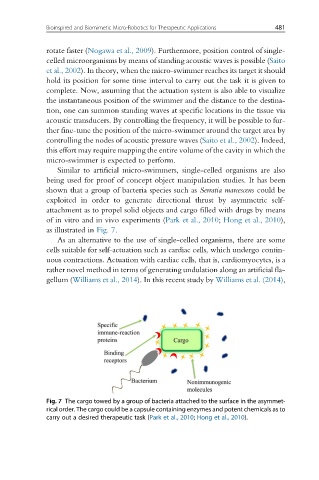Page 487 - Handbook of Biomechatronics
P. 487
Bioinspired and Biomimetic Micro-Robotics for Therapeutic Applications 481
rotate faster (Nogawa et al., 2009). Furthermore, position control of single-
celled microorganisms by means of standing acoustic waves is possible (Saito
et al., 2002). In theory, when the micro-swimmer reaches its target it should
hold its position for some time interval to carry out the task it is given to
complete. Now, assuming that the actuation system is also able to visualize
the instantaneous position of the swimmer and the distance to the destina-
tion, one can summon standing waves at specific locations in the tissue via
acoustic transducers. By controlling the frequency, it will be possible to fur-
ther fine-tune the position of the micro-swimmer around the target area by
controlling the nodes of acoustic pressure waves (Saito et al., 2002). Indeed,
this effort may require mapping the entire volume of the cavity in which the
micro-swimmer is expected to perform.
Similar to artificial micro-swimmers, single-celled organisms are also
being used for proof of concept object manipulation studies. It has been
shown that a group of bacteria species such as Serratia marcescens could be
exploited in order to generate directional thrust by asymmetric self-
attachment as to propel solid objects and cargo filled with drugs by means
of in vitro and in vivo experiments (Park et al., 2010; Hong et al., 2010),
as illustrated in Fig. 7.
As an alternative to the use of single-celled organisms, there are some
cells suitable for self-actuation such as cardiac cells, which undergo contin-
uous contractions. Actuation with cardiac cells, that is, cardiomyocytes, is a
rather novel method in terms of generating undulation along an artificial fla-
gellum (Williams et al., 2014). In this recent study by Williams et al. (2014),
Fig. 7 The cargo towed by a group of bacteria attached to the surface in the asymmet-
rical order. The cargo could be a capsule containing enzymes and potent chemicals as to
carry out a desired therapeutic task (Park et al., 2010; Hong et al., 2010).

